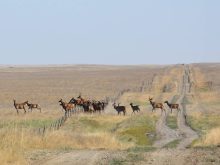DENVER, Colo. – Ninety percent of lameness in cattle starts in the foot, making it important to accurately diagnosis the condition before it becomes untreatable.
Causes vary by season and can be traced to animal handling, Tom Edwards, a private veterinarian in Nebraska with a large feedlot practice, told the National Cattlemen’s Beef Association annual convention last month.
A 2007 beef quality audit reported 31 percent of bulls and 16 percent of cows in packing house holding pens were lame.
“We are seeing more packing plants turning those away so we have to look at the whole industry to see what we can do,” said beef specialist Connie Larson of Zinpro Corp.
Read Also

Crop quality looks good this year across Prairies
Crop quality looks real good this year, with the exception of durum.
The same audit estimated three to four percent of calves and about eight percent of breeding stock are destroyed due to lameness.
Sore feet reduce animal productivity and longevity because they struggle to walk and get to feed.
“If we have lower foot problems, that means we can divert more nutrients for better growth of these animals,” Larson said.
Cattle need proper micro and macronutrients for foot and joint health.
Larson said many forages are low in critical trace elements for the foot:
•zincfor skin integrity, growth and repair;
•manganesefor skeletal soundness;
•copperfor tissue building in the foot as well as Vitamin E and selenium.
The latter two work together, but too much selenium can affect horn and claw tissue in cattle and horses and cause lameness.
Edwards said correctly diagnosing the infection is important because it often becomes a decision between whether to treat the disease or sell the animal for salvage value.
“We have to get a lot quicker on some of the decisions we make,” he said.
Watch for bobbing heads
Edwards tells clients to watch how an animal walks.
It may or may not have a pronounced limp, but the head will bob down if the back foot is lame because the animal tries to keep weight off the sore part.
The head bobbing up likely means the front foot is affected.
The foot must be examined if a problem is noted. This must be done carefully because it can be dangerous for the handler and not all chutes are designed to allow easy access to the animal’s feet.
Common foot problems
Toe abscessesare caused by a sole penetration that leads to an infection under the hoof wall.
The hoof is soft and easily worn down to the sensitive part of the foot, especially around the toes. The outside front foot is most severely affected. The outside rear toe is the next most common area.
The toes can be trimmed at the tips to relieve pressure from the swelling.
Foot rotis the most common form of lameness in cattle.
It is most often apparent one to two weeks after the soft tissue between the toes has sustained damage in mud or rough or frozen edges on the ground. The animal may pick up infectious bacteria from the soil.
Producers should examine the area of the foot between the toes. Swollen and foul smelling soft tissue means it is foot rot.
It is generally treated with long acting antibiotics. Topical medications are of little value and use of iodine in the feed has questionable results. Adding zinc to the diet may help prevent it.
“It is a lot better if we get zinc into them as a calf,” Edwards said.
Sand cracksare vertical fissures and are often seen on cow-calf operations. They are caused by nutritional deficiencies, but some genetic lines are more susceptible than others.
The cracks can spread and lead to an infection.
Laminitisresults from digestive upsets. The animal will walk slowly and softly.
The P3 bone in the foot may detach from the hoof wall, rotate and sink down and come through the sole of the foot. There is no effective treatment for beef cattle.
Hairy heel warts,also called digital dermatitis, are seen more frequently in dairy cattle but are appearing more often in beef cattle. The condition is highly infectious.
A raw, cherry-red lesion develops around the heel and the sore may develop hairy looking growths.
The animal is reluctant to walk and may cock its foot up to take tension off the heel. Antibiotics and foot baths may work, but it is a difficult condition to treat. It is often misdiagnosed as foot rot.
Other hoof injuries &infections
Hoof injuries are another cause of lameness. They most often result when an animal’s toe is caught and damaged in a poorly designed or maintained facility. Check equipment every day before using it. Small metal fragments can cause injuries.
Cattle locomotion scores
1. Normal
2. Walks with a hunched back
3. Stands and walks with a hunched back
4. Stands and walks with a hunched back, favours a leg
5. Refuses to bear weight on one leg, has difficulty walking
Those scoring in the four to five range should not go to market because they are at risk of becoming non-ambulatory.
Injuries of this type should not be left to heal on their own because they can turn into severe infections.
Producers shouldn’t scatter sand in alleyways to improve traction because it hurts cattle’s feet and can worsen a pre-existing condition.
Bruises, abrasions, fractures, sprains and strains result in swelling and are often caused by poor handling.
Cattle with foot infections need ample bedding because they will lie down a lot.
Swollen joints can also cause lameness and can take four to six weeks to heal. Swelling may be caused by an injury or an infection that developed in the joint after foot rot was improperly treated. The front fetlock, hock and elbow are the areas most commonly affected.
The bacteria E. coli, histophilus or pasteurella are the usual causes of infection.
Swollen joints are painful and the animal may not be able to eat enough for minimum body maintenance, much less gain weight. They require long-term therapy.
Euthanasia may be advised if the animal is under a long withdrawal time for a medication when the swollen joint is diagnosed.
Non-ambulatory or downer animals should be euthanized. They may be down because of a central nervous system disorder and a vet should be consulted.
Responsible care for downer animals includes giving them time to recover with feed and water and turning them so blood does not collect in one spot.
Larson said she lets a cow stay down for three days and then is likely to recommend humane euthanization.
She said it is unacceptable to drag these animals with chains. They can be moved with a sled, low boy trailer or the bucket of a front end loader.
Larson advises her clients to take courses about the proper handling and transportation of animals.















